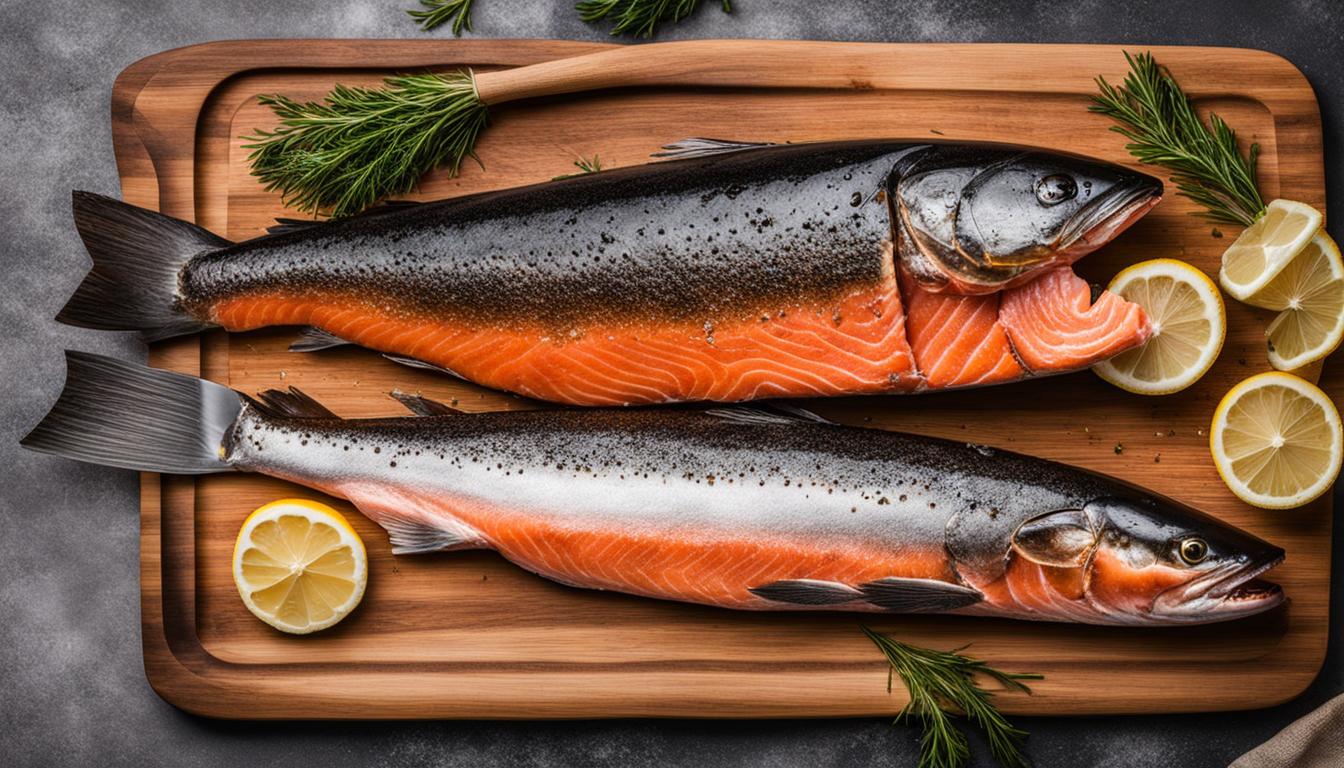As an avid culinary enthusiast, I’ve always believed that the most flavorful dishes are born from the simplest of ingredients and a touch of patience. This is especially true when it comes to crafting traditional smoked salmon using a wet brine method. It’s a process that starts a day in advance, but the end result is a dish that’s rich in flavor and impeccable in texture. The key lies within a harmonious mixture of salt, brown sugar, water, and a selection of spices – a concoction brought to a boil solely to dissolve and homogenize. Once cooled, I prefer salmon strips passed through this brine, chilled for 8-12 hours for a deep infusion of flavor.
One step not to be missed is the creation of a pellicle. This term might not be in everyone’s everyday vocabulary, but it’s essential in my kitchen. After brining, the salmon requires time to sit on a wire rack, drying to achieve a glossy exterior that will cling to the smoke during a precise three-stage smoking ritual. This graduated temperature strategy ensures the smoked salmon that graces your plate is nothing short of extraordinary.
Key Takeaways
- Wet brine method involves a simple, yet flavorful mixture of ingredients for brining salmon.
- 24-hour preparation ensures deep flavor infusion and optimal texture.
- Consistent salmon strips allow for even smoking and better taste.
- The pellicle formation is critical for smoke adhesion and moisture containment during smoking.
- Graduated smoking temperatures result in perfectly smoked salmon.
The Art of Smoking Salmon: An Introduction
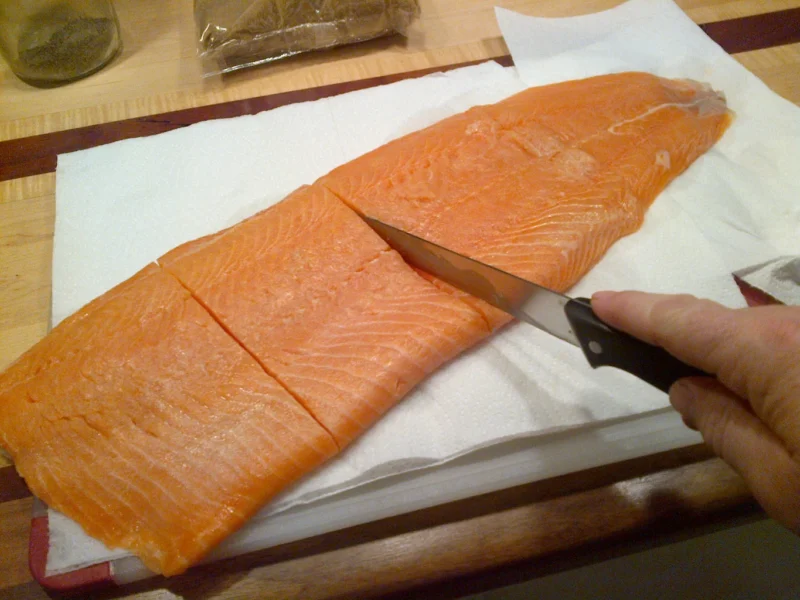
The journey of creating traditional smoked salmon is one that weaves patience with simplicity to arrive at an extraordinary destination of flavor and texture. It’s an art that once mastered, empowers you to transform the freshest of salmon into a delicacy that is much sought after for its distinctive smoky taste and delicate, refined consistency. Over the years, I’ve learned that the subtleties in smoke, the quality of wood, and timing are just as important as the preparation method itself.
Beginning with the right type of salmon is essential; wild-caught varieties such as King Salmon stand out for their rich, authentic flavor and beneficial omega-3 fats. When combined with a well-balanced wet brine solution and gently smoked over the right wood—like the understated sweetness of maple—these selections culminate in a smoked salmon experience that is both deeply satisfying and healthy.
Let’s talk about the brine—a crucial part of the recipe where simplicity shines most brightly. The wet brine method has stood the test of time in my smoking repertoire, precisely because it enhances moisture retention and infuses an even, consistent flavor throughout the salmon. A mixture of water, coarse Kosher salt, and brown sugar, sometimes with the added nuance of spices, creates the foundation for an unforgettable brined salmon that when smoked to perfection, is enjoyed in numerous ways.
- Warm, with a squeeze of fresh lemon juice, smoked salmon exudes simplicity yet sophistication on the plate.
- Chilled, layered atop a bagel swathed in cream cheese, it becomes the centerpiece of a gourmet breakfast or lavish brunch.
Indeed, whether served as a fine aperitif or the star of the main course, the smoked salmon that has evolved from carefully selected ingredients and converted by the art of smoke, commands attention and delights palates.
“The fusion of the smoke’s gentle caress and the brine’s sweet kiss converges harmoniously upon the salmon, bestowing upon it an allure that is at once robust and sublime.”
Every slice, a narrative of patience and practice; every bite, an affirmation of a method that respects both ingredient and technique. It’s time to delve into the world of smoking salmon, where the mix of tradition and personal flair can create memorable culinary experiences.
Choosing the Right Salmon for Smoking: Wild vs Farmed
When I set my mind on smoking salmon, I venture to find the freshest and highest quality fish available. This often leads to a pivotal decision: selecting either wild-caught or farmed salmon. My preference leans toward wild-caught, especially King (Chinook) salmon, renowned for its succulent texture and a higher content of beneficial omega-3 fatty acids. Indeed, its richer flavor profile remarkably enhances the smoking process, presenting a more authentic taste to the dish.
Although farmed Atlantic Salmon is more accessible, I consider the wild varieties a worthy investment for the superior culinary experience they offer. Despite higher prices and availability challenges, the gastronomic returns of wild-caught salmon are indisputable. Hence, whether for a special occasion or a weekend gastronomic endeavor, I opt for that wild catch.
Expert tip:
When sourcing salmon for smoking, consider not only the type but also the freshness. A fresh wild-caught salmon right off the boat can surpass the quality of a farmed one that has been on ice for days.
| Salmon Type Comparison for Smoking | |
|---|---|
| Aspect | Wild-Caught vs Farmed |
| Flavor | Richer, more authentic (Wild) vs Milder (Farmed) |
| Texture | Firmer, flakier texture (Wild) vs Slightly softer (Farmed) |
| Omega-3 Fatty Acids | Higher content (Wild) vs Lower content (Farmed) |
| Accessibility | Seasonal and location dependent (Wild) vs Wide availability (Farmed) |
| Price | Premium (Wild) vs More economical (Farmed) |
To gain further insight, I often engage with local fishermen and seafood vendors who share their knowledge on seasonal availability and best practices for selecting the perfect salmon. Knowing the journey from water to smoker contributes significantly to the smoking ritual and to the respect I have for this gift from the sea.
“Whether wild-caught in the turbulent Pacific or responsibly farmed, once the salmon encounters the meritorious brine and the whisper of smoke, it transcends to a delicacy that honors its origins.”
Understanding the Wet Brine Process
As I delve deeper into the craft of smoking salmon, the wet brine method continually proves its superiority. This approach to curing salmon thoroughly saturates the fish with a balanced brine mixture, ensuring that every bite delivers consistent smoked delicacy. The blend of salt, sugars, and spices do more than just add flavor; they also work to preserve the salmon’s texture, optimizing it for the smoking phase.
Why Wet Brine is Superior for Smoked Salmon
My experience has taught me that wet brining is the favored process for its exceptional capacity to deeply and evenly distribute flavors. The liquid brine engulfs the salmon, allowing the rich concoction to penetrate the fish entirely, a feat the dry brine method struggles to achieve. And it is this consistent curing that amplifies the salmon’s ability to withstand the smoking process, emerging as a glistening piece of culinary art.
Essential Smoked Salmon Brine Ingredients
- Kosher Salt: Vital for drawing moisture from the salmon to create the perfect canvas for smoking.
- Brown Sugar: Adds a touch of sweetness and complements the natural flavors of the salmon.
- Salmon Brining Liquids: A combination of water and occasionally, elements like soy sauce or white wine, to enhance depth of flavor.
- Spice Blend: Typically onion and garlic powder, these spices infuse the salmon with aromatic undertones.
The Science Behind Brining Salmon
The art of brining salmon is backed by undeniable science. As the salt from the brine interacts with the salmon filet, it alters the protein structures, enabling the fish to retain moisture more effectively. This not only ensures a juicier smoked salmon but also elevates the texture, teeing it up for the smoke to impart its magic. The use of sugar isn’t arbitrary either; it contributes to the final taste profile, coaxes the formation of a pellicle, and enables the smoke to adhere better, vastly enhancing the smoked salmon flavor.
| Brine Ingredient | Function in Brining |
|---|---|
| Kosher Salt | Moisture extraction and preservation |
| Brown Sugar | Sweetness and pellicle formation |
| Water | Base for liquid brine, facilitating even distribution |
| Spices (Onion/Garlic Powder) | Flavor complexity |
| Additional Liquids (Soy Sauce/White Wine) | Flavor depth and variation |
“Embracing simplicity and tradition with the wet brine method, I’ve unlocked a methodical approach to smoking salmon that satiates with a blend of robust savory notes underscored by sweetness, culminating in a treat that’s thoroughly enjoyable.”
Smoked Salmon Brine Recipe: Step-by-Step Guide
In my pursuit of culinary excellence, one recipe that consistently delivers in both flavor and texture is my traditional smoked salmon. Preparing the brine is as much a science as it is an art, meticulously combining simple ingredients to create an infusion that transforms salmon into a smoky delicacy. Allow me to guide you through this time-honored process that begins with a well-balanced brine.
Firstly, pour the water into a large pot. The proportion is critical here: precise measurements ensure the brine effectively cures the salmon without overpowering it. Add the Kosher salt and brown sugar, followed by the all-important onion and garlic powders. These components work in harmonious unity, each playing a role in the salmon’s transformation.
Heat the mixture gently on your stove. The objective is not to cook but to dissolve the ingredients fully into a smooth liquid brine. Patience is needed as you frequently stir, avoiding any caramelization of sugars. Upon reaching a rolling boil, I remove the pot from the heat and let the concoction cool, sometimes hastening the process by placing it in the refrigerator.
Preparation of the salmon is just as crucial. I meticulously clean the fillets with cold water, ensuring they are pristine before cutting them into unified strips. This ensures maximum surface area contact with the brine, allowing it to work its magic thoroughly. Once the brine is cool, I submerge the salmon entirely, covering it with the liquid, then refrigerate. Waiting for 8-12 hours may seem extensive, but it’s the intersection where flavor and texture are born.
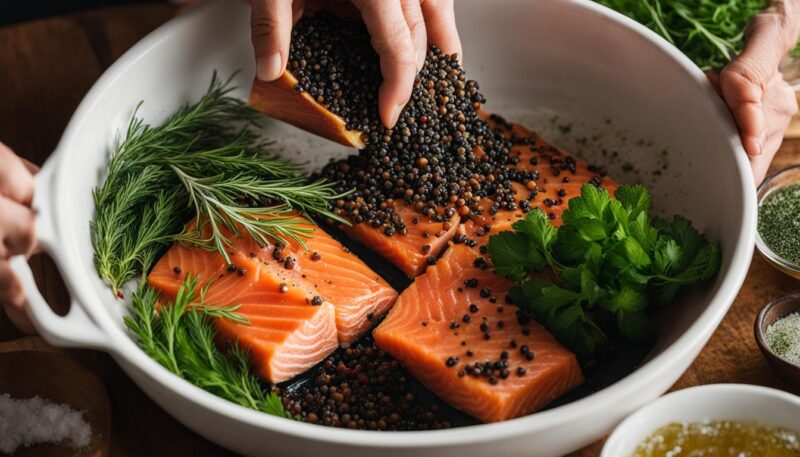
| Ingredient | Quantity | Role in Brine |
|---|---|---|
| Water | 11.5 cups | Brine base |
| Kosher Salt | 1 ⅜ cups | Flavor and curing |
| Brown Sugar | 1 ¼ cups | Sweetness and color |
| Onion Powder | 1 tsp | Aromatic notes |
| Garlic Powder | 1 tsp | Depth of flavor |
Once the brining time concludes, the transformation process isn’t over. I remove the salmon from its briny bath, gently patting it dry with clean towels. This is the precursor to the pellicle formation, which I’ll navigate in further sections of our guide. For now, remember that this introductory step towards smoking sets the stage for an exemplary final product – a testament to the confluence of time, tradition, and technique.
“In the symphony of smoked flavors, each ingredient must find its note, each step its rhythm. This is the essence of my smoked salmon brine recipe; a prelude that promises a masterpiece of taste.”
Preparing Your Salmon for the Smoker
Before introducing our salmon to the subtle smoky embrace, meticulous preparation is key. Achieving mouthwatering results begins with how we cut and prime our fish for the smoker. In my culinary journey, I’ve found that attention to detail during this stage makes a significant impact on the final flavor and texture of the smoked salmon.
How to Cut Salmon for Optimal Smoke Penetration
To ensure that our salmon absorbs the maximum amount of smoke, as well as the delectable flavors of our brine, we must slice it just right. My experience suggests cutting the salmon into consistent strips approximately 3 inches wide by 4-5 inches in length. These dimensions allow for even exposure and deep flavor penetration during the smoking process.
Let’s illustrate these dimensions with a clear visual:
| Direction of Cut | Width | Length |
|---|---|---|
| Across the Fillet | 3 inches | 4-5 inches |
Keeping our cuts uniform not only aids in the smoking fish preparation but also in presenting a visually pleasing platter to our guests.
Crafting the Perfect Pellicle for Smoked Salmon
The creation of the pellicle is an step I herald as pivotal in preparing salmon for smoking. Once our fillets have undergone the brining process, they must be patted dry and left to rest. The achievement of a shiny skin, the pellicle, ensures that our deliciously cured salmon retains moisture and absorbs smoke evenly during its time in the smoker.
The salmon drying process is not to be rushed; I allow the fillets the time they need to develop the pellicle fully. Here’s how I approach it:
- Remove the salmon from the brine and gently pat dry with paper towels.
- Lay the salmon strips on a wire rack and let them air dry to form a pellicle.
- This drying stage is typically a quiet four-hour vigil, critical for the forthcoming smoky alchemy.
An ideal pellicle has a glossy, slightly tacky surface, indicating readiness to welcome the smoky flavors eagerly.
“This element of Smoking Fish Preparation is where the culinary artistry truly begins. Here, the pellicle acts as the canvas where the smoke will paint its flavors, creating an exquisite piece of smoked art.”
By ardently observing these practices, we set ourselves up for a triumphant smoking session, knowing that our preparation will culminate in a salmon that is not only visually stunning but also boasts an impeccable depth of flavor.
Smoked Salmon Woods: Selecting the Best Flavor
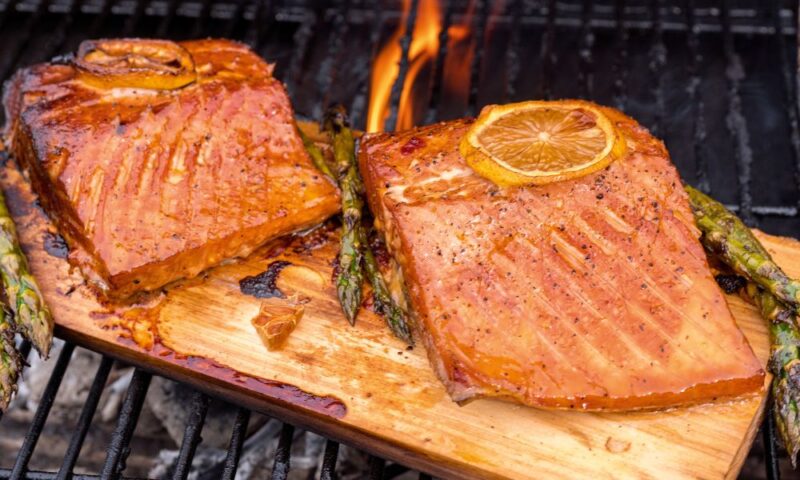
When I embark on the journey of smoking salmon, choosing the right wood is a decision I approach with the same meticulous care as selecting the fish itself. My go-to is typically maple wood, its subtle sweetness melds into the richness of the salmon like a symphony, perfectly balancing the flavors without overwhelming the palate. While the pursuit of the perfect smokiness is often a personal endeavor, there are some widely accepted guidelines that help ensure success in this culinary art.
Over time, I’ve experimented with various types of wood and discovered that not all impart the desired character to the delicate flesh of the salmon. Stronger woods like hickory, while excellent for robust meats, tend to overshadow the intrinsic flavors of salmon with their overpowering smokiness. Therefore, I generally advise against using them for this particular fish. Instead, I prefer the soft, nuanced accents provided by woods such as oak, alder, or apple, which complement rather than compete with the salmon.
| Wood Type | Flavor Profile |
|---|---|
| Maple Wood | Subtle sweet notes |
| Oak Wood | Medium smokiness, slightly sweet |
| Alder Wood | Mild with a hint of sweetness |
| Apple Wood | Sweet and fruity |
| Hickory Wood | Strong and bold |
With each smoking session, I find it fascinating how the wood transforms the flavor of the salmon. I keenly observe the way the wisps of smoke curl and cling to the fillets, anticipating the delightful taste they will impart. It is in these quiet moments by the smoker, enveloped in the aroma of sizzling wood and brined salmon, that I truly appreciate the nuanced relationship between wood and fish.
“The choice of wood is more than a matter of taste; it’s an expression of the culinary narrative I wish to tell. Through the refined whisps of maple smoke, the story of smoked salmon is unveiled on the palate.”
- Maple wood is exquisite for a delicately sweet smoky flavor.
- Oak offers a medium smokiness, slightly sweet, ideal for salmon.
- Alder provides a mild taste, with a gentle sweetness, perfect for subtle smoke profiles.
- Apple wood lends a fruity sweetness to the salmon, enhancing its richness.
- Avoid strong woods like hickory, which can overwhelm the natural salmon flavor.
As I share these insights, I encourage you to experiment with these different woods, noticing how each one interacts with your carefully prepared salmon. Discovering your personal preference is part of the enjoyment, a culinary adventure that is both rewarding and delicious. With this knowledge in hand, you’re well-equipped to select the best wood flavor for your smoked salmon, crafting a dish that will be remembered and savored.
Detailed Smoking Process: Temperatures and Timing
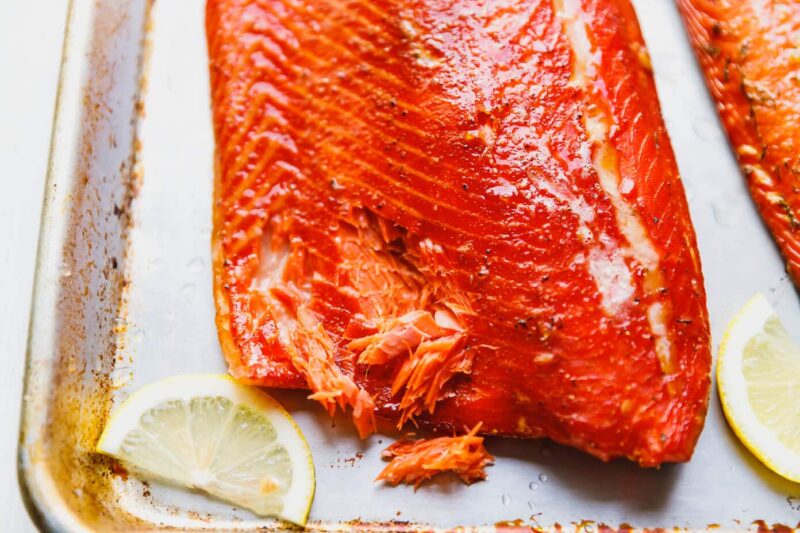
My devotion to the art of smoking salmon demands a precision that few cooking methods require. The process needs an unwavering commitment to both overview and detail, especially when journeying through the phases of smoking. I champion the three-stage smoking method as a means to ensure every morsel of salmon presents the perfect solemnity of smoke and texture. It’s a craft where low and slow always prevails, coaxing out the nuanced flavors that can only emerge from time and patience. Let’s delve into the exact temperatures and timing that convert a brined slab of salmon into a smokey masterpiece.
The Three-Stage Smoking Method for Perfect Salmon
I begin the smoking process by focusing on a critical low temperature of 100F for the initial two hours. This gentle introduction of heat allows the salmon to dry further and begin absorbing the wisps of flavor-infused smoke without the risk of cooking through too quickly. I liken this stage to the artist’s first strokes on their canvas, where the foundation is set for the forthcoming beauty.
As the second stage ensues, I elevate the temperature to 140F, maintaining this degree of warmth for another two-hour interval. It is during this phase that the salmon starts to reveal its sumptuous texture, tenderly transforming under the smoke’s persistent embrace. Just as a brine’s ingredients meld over time, the smoke’s flavors begin to permeate deeply into the brined flesh.
Approaching the final stage, my smoker ascends to 175F for the last two hours. It’s the crescendo of the smoking concert, where everything comes together, and the salmon is imbued with that desired smokey rapture. After six hours, standing at the precipice of this exhaustive journey, I know that precision in timing and temperature has, once again, born the ideal smoked salmon.
But as with any culinary endeavor, adaptations are sometimes needed. Should my smoker struggle with the commendably low temperatures, an alternative approach exists. Smoking the salmon for a duration of 4-5 hours at 165F can yield similar results – the flavor might be slightly less nuanced, but the salmon’s richness compensates with its own natural notes.
“To truly honor the tradition of smoked salmon, one must respect the chronology of heat – a triad of stages that elevate the fish from the sea’s chill to the smoke’s warmth.”
| Smoking Stage | Temperature Setting | Duration |
|---|---|---|
| 1st Stage: Initial Smoking | 100F | 2 hours |
| 2nd Stage: Midway Smoking | 140F | 2 hours |
| 3rd Stage: Final Smoking | 175F | 2 hours |
| Alternate Method: Higher Temp Smoking | 165F | 4-5 hours |
Nothing quite matches the anticipation of waiting through these meticulous six hours, as the smoke and heat wield their magic on the waiting salmon. By following this detailed smoking process, each iteration of my cooking yields salmon that is not only enriched with depth of flavor but also adorned with an irresistible smoky aroma. It is this symmetry of temperatures and timing that forges a path to smoking perfection.
Serving Suggestions for Your Homemade Smoked Salmon
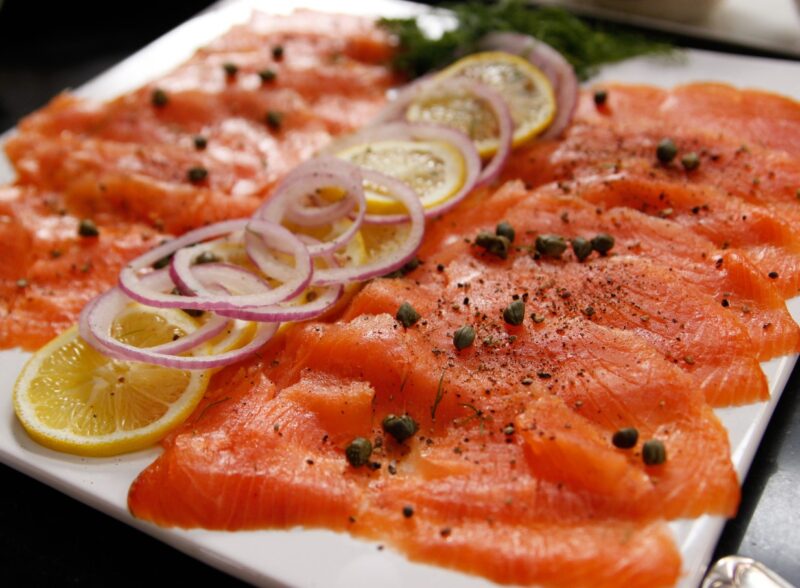
Once you’ve mastered the art of smoking salmon at home, the real joy comes in sharing and savoring your creation. I take pleasure in presenting an array of serving suggestions to inspire your own culinary presentations. Whether seeking simplicity or sophistication, these options cater to diverse preferences and occasions, ensuring that homemade smoked salmon remains a versatile staple in your gourmet repertoire.
The delight of homemade smoked salmon is in its versatility. Warm or cold, it can elevate the simplest snack to an occasion. Here are some of my favorite ways to serve smoked salmon:
- As an elegant starter, drape it over a slice of cucumber, topped with a dollop of crème fraîche and fresh dill.
- To create a rustic yet refined appetizer, serve it alongside crackers with a bowl of caper-speckled cream cheese.
- Savor it in a more casual setting atop crisp toasts with a smear of avocado – a fusion of textures and flavors.
At brunch, there is nothing more classic or satisfying than layering smoked salmon with a velvety spread of cream cheese on a toasted bagel. Accompany it with slices of red onion and capers for a satisfying bite that is both indulgent and comforting.
| Serving Style | Accompaniments | Occasion |
|---|---|---|
| Elegant Appetizer | Cucumber, crème fraîche, dill | Cocktail parties, formal gatherings |
| Rustic Starter | Crackers, cream cheese, capers | Casual get-togethers, game night |
| Brunch Classic | Bagel, cream cheese, red onion | Weekend brunch, family breakfasts |
For a creative twist on the traditional, consider conjuring a smoked salmon dip. Puree smoked salmon with cream cheese, lemon juice, herbs, and a hint of horseradish for a spread that’s both rich and zesty, perfect for dunking fresh vegetables or artisan breads.
“The allure of homemade smoked salmon lies not just in its smoky depth of flavor but in its adaptability to a multitude of culinary canvases. Each serving suggestion is an invitation to explore and an opportunity to indulge.”
Whether you’re hosting an upscale event or simply enjoying a quiet evening at home, these serving suggestions ensure that your homemade smoked salmon transforms from a simple delicacy to the highlight of any meal.
Storage Tips for Smoked Salmon
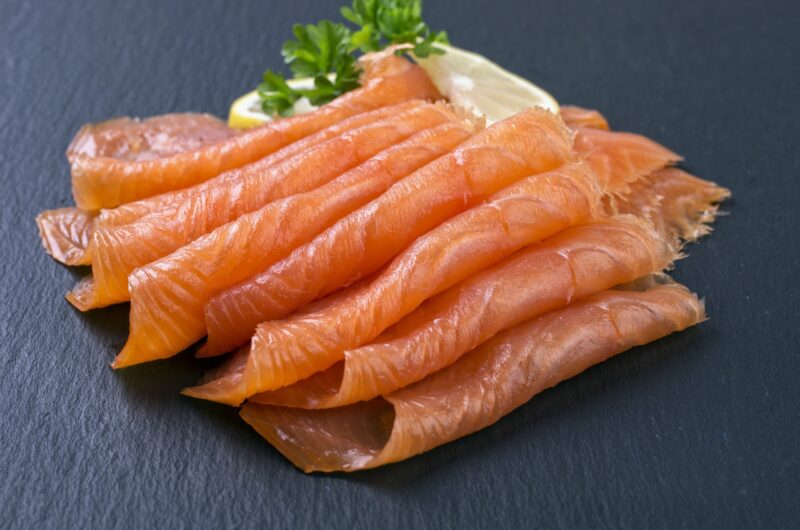
After meticulously following the smoking process, it is paramount to preserve the exquisite flavors and textures of your smoked salmon. As someone who takes pride in their culinary creations, I’m going to share my methods for properly storing and extending the shelf life of this delicate fish. The right storage practices are crucial for maintaining the sumptuous quality of homemade smoked salmon.
How to Store Freshly Smoked Salmon
Once your salmon has absorbed the rich smokiness and reached its perfect doneness, allowing it to cool is the first step in the preservation process. Cooling must occur at room temperature, away from direct sunlight, and under a watchful eye to prevent spoilage. Subsequently, the key to preserving smoked fish is to wrap it tightly. I use plastic wrap, followed by a layer of aluminum foil to shield against any air or odors that might infiltrate the delicate flesh. Promptly refrigerating your wrapped salmon is essential; it should rest in the coldest part of the refrigerator to maintain its freshness.
“In my kitchen, rigorously wrapping and chilled storage are the sentinels of freshness for my smoked salmon, ensuring each slice remains as luscious as when it first emerged from the smoker.”
Extending the Shelf Life of Your Smoked Salmon
To truly extend the enjoyment of smoked salmon, Salmon Storage Practices involve more than just refrigeration. As soon as the salmon is cooled and wrapped, you have the option to employ vacuum-sealing, a method I find remarkably effective in extending smoked salmon shelf life. An airtight vacuum-sealed bag not only prevents freezer burn but also significantly extends the salmon’s shelf life, allowing you to savor its flavors well beyond just a few days.
| Storage Method | Description | Shelf Life |
|---|---|---|
| Refrigeration (Wrapped) | Fish is wrapped tightly in plastic and foil, then refrigerated. | Up to 1 Week |
| Vacuum-Sealing (Refrigerated) | Fish is vacuum-sealed to remove air before chilling. | 2-3 Weeks |
| Vacuum-Sealing (Frozen) | Fish is vacuum-sealed and frozen for long-term storage. | 2-3 Months |
Indeed, by implementing meticulous wrapping and a vacuum-sealing technique, my smoked salmon remains a sought-after delicacy in both flavor and freshness. Whether you choose to enjoy it within days or wish to preserve it for later indulgence, these storage tips ensure that each serving of your homemade smoked salmon retains its taste and texture as intended. To all my fellow aficionados of this fine art, may your endeavors in smoking and storing salmon bring forth abundance in both flavor and longevity.
Common Mistakes to Avoid When Smoking Salmon
As a seasoned smoker of salmon, I’ve learned that attention to detail is non-negotiable. While mastery comes with practice, awareness of common pitfalls can expedite culinary success. Overbrining, for instance, is a frequent error, leading to an overly salty taste and an unappealing mushy texture that can mar the entire experience. To avoid this, I always adhere to recommended brine times and never keep my salmon submerged longer than necessary.
Temperature control is another crucial factor; too high or inconsistent temperatures can swiftly result in overcooked salmon. Smoking salmon is a symphony where every note must be in harmony with the rhythm of heat. It is imperative to keep a vigilant eye on your smoker’s temperature gauge, making adjustments as needed to maintain the ideal climate for your fish.
A well-formed pellicle is equally important. This tacky, glossy layer on the surface of the brine-soaked salmon is the secret to smoke’s adherence. Skipping this vital step or curbing its development time can diminish the smoke’s capacity to bond, leading to a final product that may look the part but falls short in the coveted smoky flavor department. Here are some specific missteps to dodge:
- Overbrining: Leads to overpowering saltiness and breakdown in texture.
- Inconsistent Temperatures: Causes uneven cooking and potential dryness.
- Impatient Pellicle Formation: Results in insufficient smoke adhesion.
| Common Mistake | Consequences | Prevention Tips |
|---|---|---|
| Overbrining | Salty flavor, mushy texture | Stick to recipe times, monitor brining carefully |
| Poor Temperature Control | Overcooked, dry salmon | Use precise equipment, adjust as needed |
| Inadequate Pellicle | Lack of smoky flavor | Allow salmon to dry until tacky |
“While capturing the smoky essence of the sea is the target, allowing salmon to swim too long in the brine or losing control over the flame can end in a culinary misadventure. The devil, as they say, is in the details.”
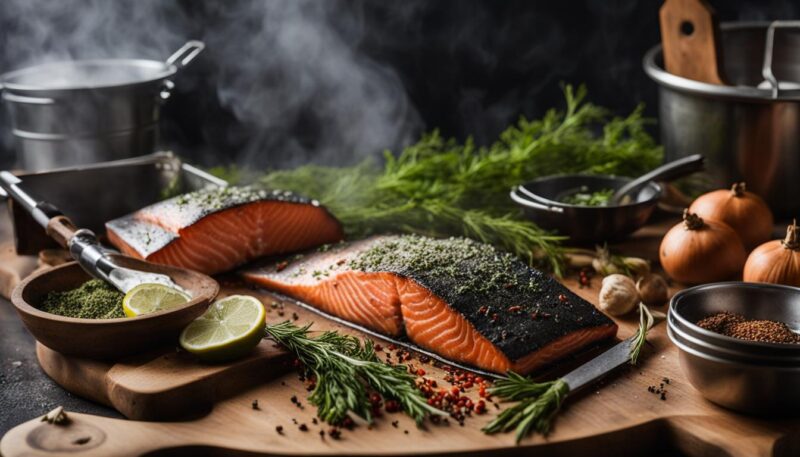
I’ve often found that beginners are tempted to peek frequently or expedite processes. Restraint is key; trust in your preparation, and patience will be your greatest tool. By averting these common mistakes, every smoking enthusiast can craft a smoked salmon that proudly bears the hallmark of patience, skill, and respect for tradition.
Conclusion: The Mastery of Smoked Salmon Perfection
In my culinary voyage, the mastery of raw salmon recipes, particularly the traditional art of crafting smoked salmon through the meticulous wet brine technique, unveils a narrative of patience and precision. Every step, from discerning between wild or farmed salmon to the intricate composition of the brine, and culminating in the revered smoking ritual, shapes an experience that lingers long in memory.
Beyond the mere steps of a recipe, it’s a journey of immersion in technique—a dance between intuition and meticulousness. Each decision, from the selection of the finest ingredients to the homage paid to time-honored smoking traditions, is a brushstroke in the creation of sublime smoked salmon. The culmination isn’t just a dish but a testament to the dedication, foresight, and profound respect for the raw ingredient—an essence that resonates through the nuances of every bite
As I present this delectable fish, either as a sophisticated centerpiece or as a simple, yet satisfying treat, the importance of proper storage and avoidance of common smoking faults cannot be overstated. These practices ensure that every slice of smoked salmon continues to embody the quality and taste that were so carefully cultivated through each preparatory phase. All in all, mastering this traditional indulgence promises rewarding flavors for special occasions and everyday meals alike here in the United States.
FAQ
What is the preferred method for smoking salmon?
The wet brine method is preferred for smoking salmon as it ensures consistent flavor, moisture retention, and a visually appealing final product.
What are the key ingredients in a traditional smoked salmon wet brine?
Essential ingredients for a smoked salmon wet brine include Kosher salt, brown sugar, spices such as onion and garlic powder, and sometimes soy sauce or white wine for extra flavor.
Why is wild-caught salmon recommended for smoking over farmed salmon?
Wild-caught salmon, such as King (Chinook), is recommended for its richer flavor and higher content of healthy fats. However, farmed salmon can also be used if wild-caught is not available.
How does brining salmon affect its moisture and flavor?
Brining salmon with salt and sugar affects the protein structure of the fish, enhancing water retention for a juicier end product and improving the overall flavor profile.
Can you provide a basic step-by-step guide for preparing a smoked salmon brine?
To prepare a smoked salmon brine, mix water, Kosher salt, brown sugar, onion powder, and garlic powder in a pot. Bring the mixture to a boil to dissolve the ingredients, then cool before submerging salmon fillets for 8-12 hours.
How should salmon be cut for smoking?
Salmon should be cut into consistent strips, approximately 3 inches wide by 4-5 inches long, to ensure even exposure to the smoke and effective brine penetration.
What is a pellicle, and why is it important for smoking salmon?
A pellicle is a shiny skin that forms on the surface of the salmon after drying post-brining. It helps the smoke to adhere better to the fish and seals in moisture during smoking.
What wood flavors are best for smoking salmon?
Maple wood is a popular choice for its subtle sweetness. Other suitable options include alder, apple, and oak. Stronger flavors like hickory are generally avoided as they can overpower the salmon’s taste.
What is the three-stage smoking method for salmon?
The three-stage smoking method includes starting at a low temperature of 100F for 2 hours, increasing to 140F for another 2 hours, and finishing at 175F for the final 2 hours.
How should freshly smoked salmon be stored?
Freshly smoked salmon should cool down, be wrapped tightly, and refrigerated. It can be kept in airtight containers or vacuum-sealed for extended freshness.
How can you extend the shelf life of smoked salmon?
To extend the shelf life of smoked salmon, store it in airtight containers or utilize vacuum-sealing. Keep it refrigerated to maintain quality and prolong enjoyment.
What are some common mistakes to avoid when smoking salmon?
Avoid overbrining which leads to overly salty and mushy salmon, and ensure careful temperature control to prevent overcooking. Additionally, a well-formed pellicle is crucial for proper smoke adherence.

